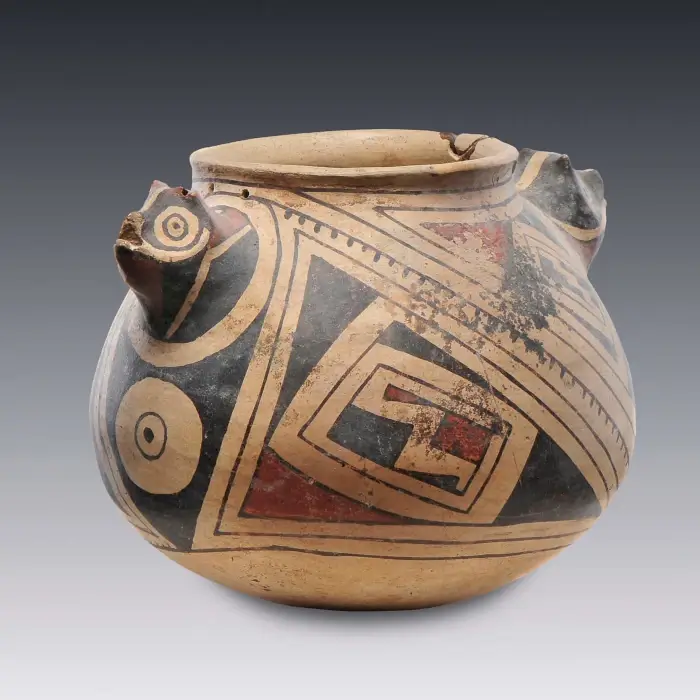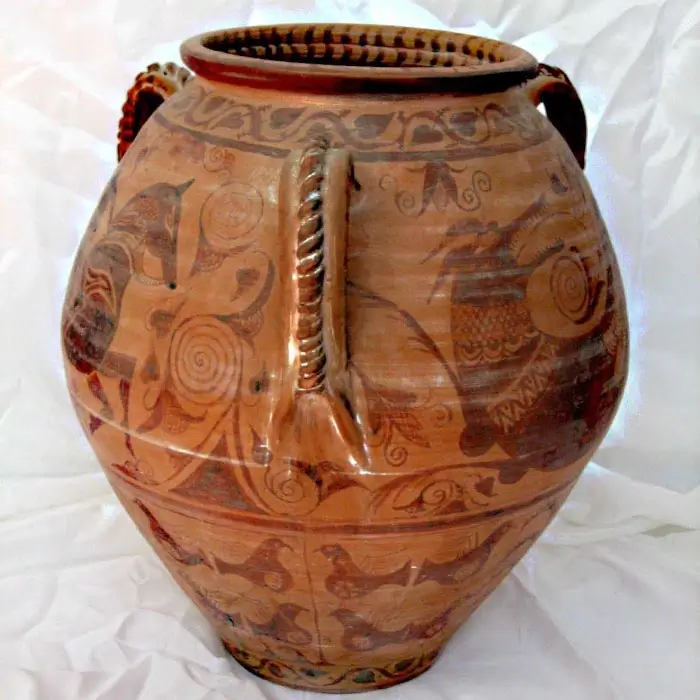Chimú Ceramics: Incredible art in clay
Chimú pottery is a distinctive type of ceramic produced by the civilization of the same name, which flourished on the northern coast of present-day Peru between 900 and 1470 A.D., before being conquered by the Incas.
This ceramic is notable for its fine finish and glossy black color, the result of specialized firing techniques in a reducing atmosphere.
It is an important expression of the craftsmanship and worldview of this pre-Columbian culture, reflecting both everyday aspects of life and religious and mythological beliefs.

Location and historical context of Chimú ceramics
This pre-Columbian pottery was made by the Chimbú people, settled on the northern coast of present-day Peru, mainly in the valley of the Moche River, with its capital at Chan Chan, near the present-day city of Trujillo.
This civilization developed approximately between 900 and 1470 A.D., succeeding the Moche culture and being contemporary with other Andean cultures.
Chimú expansion came to an end with the Inca conquest around 1470 AD, when they were incorporated into the growing Inca empire. The integration of this people into the Tawantinsuyu (Inca Empire) facilitated the spread of their craft techniques, but also marked the decline of their independent culture.
Distinctive characteristics of Chimú ceramics
Chimú pottery is distinguished by several unique characteristics that differentiate it from other cultures of the American continent.
Its aesthetics is remarkably sober and elegant, with a predominance of black and brown colors due to the reduction technique used during the firing process.
The designs tended to be minimalist, with a predilection for the representation of stylized anthropomorphic and zoomorphic figures, as well as scenes from the daily life and mythology of the Chimú culture.
These are some of the characteristics that differentiate it from other forms of pottery:
Its shiny black color, as mentioned before, is the result of firing techniques in reducing atmospheres that changed the iron oxide of the clay to a form that gave this characteristic finish.
This technique was not only an aesthetic choice, but also increased the impermeability and hardness of the pieces.
Although predominantly monochromatic, Chimú ceramics sometimes featured incised or relief decorations. These decorations included geometric motifs, designs inspired by nature and scenes from daily life, as well as depictions of deities and rituals.
The Chimú mastered modeling and the creation of pieces with molds, as well as the hand lathe.
They also used burnishing to give the surfaces a smooth and shiny finish, as well as the application of engobes and paints before firing to add decorative details.
Although clearly distinctive, Chimú ceramics also show the influence of predecessor cultures, such as the Moche, adapting and evolving earlier styles and techniques to create a unique cultural expression.
Most relevant pieces of Chimbú ceramics
Stirrup-handle bottles: These bottles feature a spherical base with a stirrup-shaped handle connecting the mouth to the body. They have the typical glossy black finish and often feature incised or embossed decorations.
Sculptures: Ceramic sculptural figures represent a variety of themes, from human figures in various daily activities and ceremonial roles to representations of animals and mythological beings.
Ceremonial vessels: Some vessels are elaborated with complex shapes and detailed decorations that include geometric and symbolic motifs. These pieces may have been used in ritual contexts, reflecting the importance of ceramics in religious practices.
Funeral urns: The urns used to contain human remains or as offerings in tombs are significant, as they illustrate the Chimú’s funerary practices and their beliefs in the afterlife.
Pitchers and bowls: The utilitarian pieces, such as pitchers and bowls, although simpler in decoration, their decoration and shapes help us to understand the daily life of the Chimú.

Buy pre-Columbian ceramics
Find original pieces and also reproductions identical to the traditional ceramic works that were made in pre-Columbian America and that are only found in museums, making them affordable.
Cultural and social significance of Chimbú pottery
Chimú pottery was not simply an object of daily use or a work of art; it had a strong cultural, social and religious significance.
The Chimú practiced the cult of the Moon, considered more powerful than the Sun, and their rituals included offerings and human sacrifices, especially of children during periods of crisis or to celebrate important events.
Ceramic pieces were used in a variety of contexts, including rituals, offering ceremonies to the gods and as part of funerary offerings.
In addition, pottery served as a means of communication, transmitting myths, values and social norms through its iconographic representations.
Learn more about this Andean town
The Chimú were skilled farmers, fishermen and traders, maintaining extensive trade networks that allowed them to exchange products with distant regions. Their society was highly stratified, with a ruling elite presiding over a complex system of social classes.
The history of the Chimú is characterized by its remarkable urban, architectural and artisanal development, with Chan Chan being one of the largest adobe urban centers in antiquity. This city was composed of nine large palace complexes, plazas, warehouses and a vast network of irrigation canals, which demonstrates the high level of social organization and skill in the management of water resources in a desert environment.
Influences and cultural exchanges
While Chimú ceramics present their own distinctive characteristics, the influence of contemporary and predecessor cultures is also evident in their art. There are elements that refer to the iconography of the Moche culture, a direct ancestor of the Chimú in the northern region of Peru. Likewise, certain aspects of ceramic technology may have been influenced by exchanges with other Andean cultures.
Chimú ceramics also show an openness to new influences in the late period of its development, particularly after the expansion of the Inca empire. This cultural contact is reflected in some stylistic and technical variations, which shows the adaptive capacity and dynamism of the Chimú artisans.




